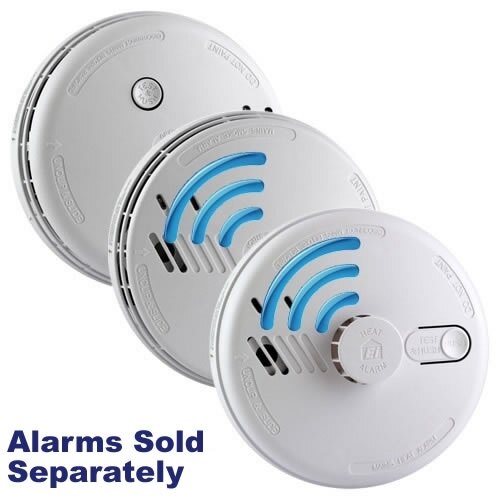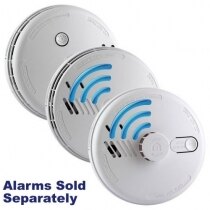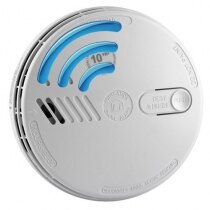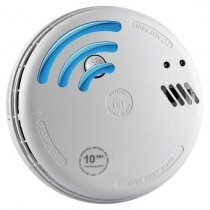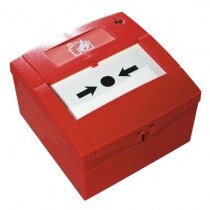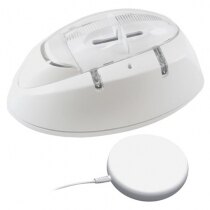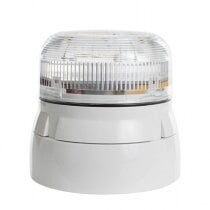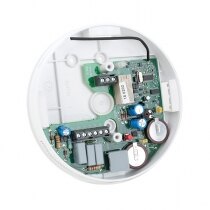-
Contact
Sales & Customer Service
0800 612 6537 support@safelincs.co.uk Live ChatDelivery Enquiries
0800 077 6149 - Resources
Fire & Safety Solutions
CALL OUR TEAM NOW 0800 612 6537
Lines open today 8am - 6pm
Quick Delivery
From £3.19 inc VAT
Live Chat - Online
Instant help & Advice
Trade Discounts
and exclusive pricing
0% Credit Available
Open an account now
5 Star Customer Feedback
Aico Mains Powered Radio-Interlinked Smoke Alarms with Lithium Back-up Battery Ei160RF Series
Discontinued Product
This product has been discontinued.
alternative product
Mains Powered Smoke Alarms with Lithium Back-up Ei3000RF Series
- Available in Optical, Heat and Combined Optical and Heat
- Mains powered alarms with tamper-proof lithium back-up batteries
- Suitable for BS 5839-6: 2019 Grade D1 installations
- Supplied with an Ei3000MRF SmartLINK Module for radio-interlinking
- Hybrid (wired or wireless) interlinking with up to 12 compatible devices
- Please note: alarms are sold individually
- Also suitable for both the Welsh and Scottish 2022 legislation
£106.52 inc VAT
£88.77 ex VAT
Product Overview
Interconnection
Compatible Alarms
Carbon Monoxide Alarms
Ancillary Products
Wiring Explained
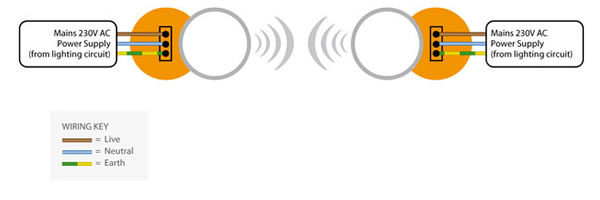 Technical Data
Technical Data
FAQs (8)
The Ei160RC series of mains powered radio-interlinked alarms contain a sealed lithium back up battery that lasts the life of the alarm. Supplied with a radio-frequency base plate with a 30m signal range, up to 12 Ei160RC radio-interlinked smoke alarms can be wirelessly connected within one system. Unlike traditional wired connection systems, the radio-interlinked alarms save time, cost and mess during installation, and the sealed lithium battery stops attempts of battery removal.
- Kitemarked to BS EN 14604:2005 and CE marked
- Suitable for installations complying to BS 5839-6: 2013 Grade D, E and F
- Each unit consists of a radio-frequency base-plate and the Ei160 series alarm sensor
- Re-chargeable lithium battery backup guaranteed for 10 years
- Requires no cables between units
- Can be powered from the nearest light fitting
- Ideal for extensions, new build, small let premises and small businesses
- Available in two alarm sensor versions
- Ionisation: best for landings
- Optical: best for hallway, living rooms and bedrooms
- Each unit can transmit up to 30m indoors
- Built-in radioLINK repeater function allows for the RF signal to work around obstructions
- Units are programmed to recognise other units in the same circuit
- A maximum of 12 alarms can be interconnected
- Features test and hush button facility and LEDs to show correct power supply
- Made by Ei Electronics in Ireland
- 5 year warranty
- Also available:
Please Note: These units use the radio-interlink frequency 868.499MHz. This bandwidth is restricted for safety products, therefore the chances of interference should be limited.
The table below shows all the units that can interconnect with the EI168RC/Ei160RC series.
Alarms from the Same Series| Model Number | Type of unit | Type of interconnection |
| Ei168RC/Ei161 | Ionisation Smoke Alarm | Radio-interlinked using the Ei168RC base |
| Ei164eRF | Heat Alarm | Radio-interlinked using the Ei100MRF module |
| Ei168RC/Ei166 | Optical Smoke Alarm | Radio-interlinked using the Ei168RC base |
| Model Number | Type of unit | Type of interconnection |
| Ei605TYCRF | Optical Alarm | Radio-interlinked |
| EI603TYCRF | Heat Alarm | Radio-interlinked |
| Ei168RC/Ei2110 | Multi Sensor Smoke & Heat Alarm | Radio-interlinked using the Ei168RC base |
| Model Number | Type of unit | Type of interconnection |
| Ei208WRF | Battery powered CO detector | Radio-interlinked |
| Ei262 | Mains powered CO detector | Radio-interlinked |
| Model Number | Type of unit | Type of interconnection |
| Ei407 | Wireless Manual Call Point | Radio-interlinked |
| Ei411H | Wireless Locate, Hush and Remote test switch | Radio-interlinked |
| Ei412 | Wireless Fire and CO Alarm Control Switch | Radio-interlinked |
| Ei450 | Wireless Fire and CO Alarm Controller | Radio-interlinked |
Wiring Explained
The radio interlinked Ei160 series of alarms require a 230V AC mains power supply to each unit. Up to 12 alarms can be wirelessly interconnected by radio signal.
To obtain a mains feed, each alarm can be connected to its nearest lighting circuit using 2 core and earth cable. Please note that the separate lighting circuits must have a permanent live supply to all alarms. Radio frequency signals are then used for the wireless interconnection. Please see the diagram below:-

| Product Code |
Ei161 - Radio-Interlinked Ionisation Smoke Alarm: EI168RC161RC Ei166 - Radio-Interlinked Optical Smoke Alarm: EI168RC166RC |
|---|---|
| Brand | EI Electronics |
| Back-Up Battery | 10 year sealed lithium cell |
| Dimensions (HxDia) | Ionisation: 54x150mm Optical: 64x150mm Multi-Sensor: 78x152mm |
| Operating Temperature | 0 to 40°C |
| Relative Humidity | 15% to 95% Relative Humidity |
| Sound Output | 85dB |
| Weight | EI168RC161RC: 0.453kg EI168RC166RC: 0.492kg |
| Product Datasheets |
Q. What sort of smoke alarm system would I need to install for a HMO?
A.
BS 5839-6 recommends that one or two storey HMOs with an individual floor area of no more than 200sqm (not the total of both floors) should have a Grade D smoke alarm system installed. Grade D refers to mains powered smoke alarms with a back up battery power supply. The alarms can be interlinked either by wire or by radio signal and the system does not require a separate fire alarm panel. For HMOs of 3 storey or higher, a Grade A panel system would need to be installed. This can cover the whole of the building, or can be used just for the communal areas with a separate Grade D system installed for the individual dwellings. For both applications, the level of cover should be a minimum of LD3 (in all escape routes) but this may change according to the fire risk assessment.
Q. Can the Ei160 RF series be connected to a CO detector?
A.
Yes, you can use either the battery powered Ei208WRF CO detector or the mains powered Ei262 CO detector. We also recommend that you fit a Ei412 locator switch to allow you to find out if an alarm was caused by CO gas or a fire!
Q. My ceiling light is on a dimmer switch. Can I still power my radio-interlinked mains smoke alarms from this lighting supply?
A.
In modern housing the lighting circuit will travel around your house with the lights being fed from it. Between the circuit and the light will be a switch (or in this case a dimmer) which will control the light. Your mains powered alarms are connected directly to the circuit and have constant power, so are not affected by switches or dimmers. In older homes that have not had the electrics updated this may not be the case so it is advisable to consult an electrician.
Q. I need to connect my EI160 alarms wirelessly to my sprinkler system so that if the sprinkler activated, it would send a signal to my alarms to sound. What can I use
A.
You would connect the EI408 switched input to the sprinkler system which would activate the EI168 wireless base to sound the alarms
Q. I have added an Ei168RC164RC wireless linked heat detector to my garage some time after the installation of various other wireless Ei160 detectors in the house. What do I have to do to get the system to recognise the new detector please?
A.
Show All To get the Ei168RC164RC to communicate with the existing alarms, you would need to housecode all the units again. Press the housecode button on the new Ei168RC base and on each of the existing units.
Customer Reviews
12 customers have given this product an overall rating of 4.8 out of 5
Reviews by real customers
All of our product reviews are written by real customers that have purchased this product from us and are published without modification.Rating: 5 / 5 Stars
Reviewed by:
Very easy to install Downside of this product is that once the sensors have been radio interlinked the system cannot be added to with additional sensors
Published on: 8th November 2015
Rating: 5 / 5 Stars
Reviewed by:
Neat in appearance and easy to install Products were delivered very quickly from time of order
Published on: 8th November 2015
Rating: 5 / 5 Stars
Reviewed by:
just what I needed I found the instrcutions confusing and used the mounting plate from the box with the sensor head. I later realized that if using radio to link the alarms this mounting plate could be discarded. The instructions could have this point and saved me some time.
Published on: 13th December 2014
Looking for more information?
If you have any questions or would like more information about this product you can ask one of our specialists.
Live Chat Available Now
Direct Telephone
01507 464181





















